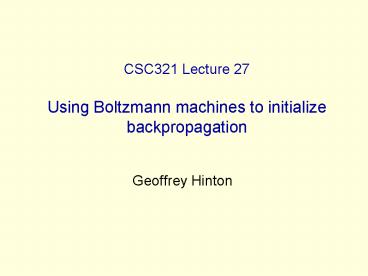CSC321 Lecture 27 Using Boltzmann machines to initialize backpropagation - PowerPoint PPT Presentation
Title:
CSC321 Lecture 27 Using Boltzmann machines to initialize backpropagation
Description:
The non-linearity used for reconstructing bags of words ... Train on bags of 2000 words for 400,000 training cases of business documents. ... – PowerPoint PPT presentation
Number of Views:62
Avg rating:3.0/5.0
Title: CSC321 Lecture 27 Using Boltzmann machines to initialize backpropagation
1
CSC321 Lecture 27Using Boltzmann machines to
initialize backpropagation
- Geoffrey Hinton
2
Some problems with backpropagation
- The amount of information that each training case
provides about the weights is at most the log of
the number of possible output labels. - So to train a big net we need lots of labeled
data. - In nets with many layers of weights the
backpropagated derivatives either grow or shrink
multiplicatively at each layer. - Learning is tricky either way.
- Dumb gradient descent is not a good way to
perform a global search for a good region of a
very large, very non-linear space. - So deep nets trained by backpropagation are rare
in practice.
3
The obvious solution to all of these problems
Use greedy unsupervised learning to find a
sensible set of weights one layer at a time. Then
fine-tune with backpropagation
- Greedily learning one layer at a time scales well
to really big networks, especially if we have
locality in each layer. - Most of the information in the final weights
comes from modeling the distribution of input
vectors. - The precious information in the labels is only
used for the final fine-tuning. - We do not start backpropagation until we already
have sensible weights that already do well at the
task. - So the learning is well-behaved and quite fast.
4
Modelling the distribution of digit images
2000 units
The top two layers form a restricted Boltzmann
machine whose free energy landscape should model
the low dimensional manifolds of the digits.
500 units
The network learns a density model for unlabeled
digit images. When we generate from the model we
often get things that look like real digits of
all classes. More hidden layers make the
generated fantasies look better (YW Teh, Simon
Osindero). But do the hidden features really help
with digit discrimination? Add 10 softmaxed units
to the top and do backprop.
500 units
28 x 28 pixel image
5
Results on permutation-invariant MNIST task
- Very carefully trained backprop net with
1.53 one or two hidden layers (Platt Hinton) - SVM (Decoste Schoelkopf)
1.4 - Generative model of joint density of
1.25 images and labels (with unsupervised
fine-tuning) - Generative model of unlabelled digits
1.2 followed by gentle backpropagtion - Generative model of joint density
1.1 followed by gentle backpropagation
6
Deep Autoencoders
- They always looked like a really nice way to do
non-linear dimensionality reduction - They provide mappings both ways
- The learning time is linear (or better) in the
number of training cases. - The final model is compact and fast.
- But it turned out to be very very difficult to
optimize deep autoencoders using backprop. - We now have a much better way to optimize them.
7
How to find documents that are similar to a query
document
- Convert each document into a bag of words.
- This is a vector of word counts ignoring the
order. - Ignore stop words (like the or over)
- We could compare the word counts of the query
document and millions of other documents but this
is too slow. - So we reduce each query vector to a much smaller
vector that still contains most of the
information about the content of the document.
fish cheese vector count school query reduce bag
pulpit iraq word
0 0 2 2 0 2 1 1 0 0 2
8
The non-linearity used for reconstructing bags of
words
- Divide the counts in a bag of words vector by N,
where N is the total number of non-stop words in
the document. - The resulting probability vector gives the
probability of getting a particular word if we
pick a non-stop word at random from the document. - At the output of the autoencoder, we use a
softmax. - The probability vector defines the desired
outputs of the softmax. - When we train the first RBM in the stack we use
the same trick. - We treat the word counts as probabilities, but we
make the visible to hidden weights N times bigger
than the hidden to visible because we have N
observations from the probability distribution.
9
Performance of the autoencoder at document
retrieval
- Train on bags of 2000 words for 400,000 training
cases of business documents. - First train a stack of RBMs. Then fine-tune with
backprop. - Test on a separate 400,000 documents.
- Pick one test document as a query. Rank order all
the other test documents by using the cosine of
the angle between codes. - Repeat this using each of the 400,000 test
documents as the query (requires 0.16 trillion
comparisons). - Plot the number of retrieved documents against
the proportion that are in the same hand-labeled
class as the query document.































